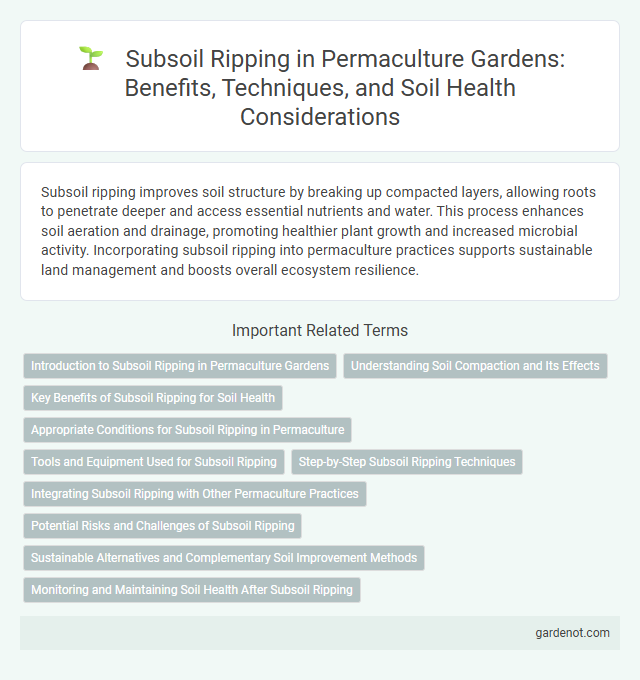Subsoil ripping improves soil structure by breaking up compacted layers, allowing roots to penetrate deeper and access essential nutrients and water. This process enhances soil aeration and drainage, promoting healthier plant growth and increased microbial activity. Incorporating subsoil ripping into permaculture practices supports sustainable land management and boosts overall ecosystem resilience.
Introduction to Subsoil Ripping in Permaculture Gardens
Subsoil ripping in permaculture gardens enhances soil structure by breaking up compacted layers beneath the topsoil, improving water infiltration and root penetration. This technique stimulates microbial activity and nutrient cycling, essential for sustainable plant growth and ecosystem health. Implementing subsoil ripping supports long-term soil fertility, reduces erosion, and increases overall garden productivity.
Understanding Soil Compaction and Its Effects
Soil compaction limits root growth and reduces water infiltration, causing poor plant health and decreased crop yields. Subsoil rip breaks through compacted layers beneath the topsoil, enhancing aeration and nutrient availability for deeper roots. This practice improves soil structure, promotes microbial activity, and supports sustainable permaculture systems.
Key Benefits of Subsoil Ripping for Soil Health
Subsoil ripping enhances soil health by breaking up compacted layers, which improves water infiltration and root penetration. This process increases soil aeration, promotes microbial activity, and enhances nutrient cycling essential for plant growth. By restoring natural soil structure, subsoil ripping supports long-term sustainability in permaculture systems.
Appropriate Conditions for Subsoil Ripping in Permaculture
Subsoil ripping in permaculture is most effective in well-drained soils with compacted layers that restrict root growth and water infiltration. Ideal conditions include relatively dry soil to prevent smearing and when moisture content is sufficient to allow proper fracture of hardpan layers. This practice optimizes soil aeration and water movement, enhancing root development and microbial activity critical for sustainable permaculture systems.
Tools and Equipment Used for Subsoil Ripping
Subsoil ripping requires robust tools like heavy-duty subsoilers or ripper shanks attached to tractors for effective deep soil penetration. Equipment often features replaceable ripper points made from high-strength steel to withstand dense, compacted layers. Hydraulic systems enhance control and depth adjustment, maximizing soil aeration and root development for permaculture applications.
Step-by-Step Subsoil Ripping Techniques
Subsoil ripping enhances soil aeration and root penetration by breaking compacted layers below the surface using a ripper tine or chisel plow. Begin by assessing soil moisture to ensure it's neither too wet nor too dry, then mark straight rows for ripping to maintain consistency. Adjust equipment depth to penetrate the hardpan without disturbing topsoil structure, completing passes at slow speeds for effective subsoil fracturing and improved water infiltration.
Integrating Subsoil Ripping with Other Permaculture Practices
Integrating subsoil ripping with permaculture practices enhances soil structure, improves water infiltration, and promotes deep root growth for perennial plants. Combining subsoil ripping with mulch layers, cover cropping, and swales creates synergistic effects that boost soil fertility and resilience. These integrated methods optimize nutrient cycling and support diverse ecosystems essential for sustainable land management.
Potential Risks and Challenges of Subsoil Ripping
Subsoil ripping can improve soil aeration and root penetration but poses risks such as soil structure disruption, increased erosion, and potential damage to underground ecosystems. Excessive ripping may lead to compaction below the ripped layer, reducing long-term soil health and water infiltration. Careful assessment of soil moisture and composition is essential to minimize these challenges and maintain sustainable permaculture practices.
Sustainable Alternatives and Complementary Soil Improvement Methods
Subsoil ripping enhances water infiltration and root penetration by breaking compacted layers, promoting healthier soil structure and increased microbial activity. Sustainable alternatives like deep-rooted cover crops and biochar application improve soil porosity and nutrient retention without heavy machinery impact. Complementary methods such as vermicomposting and mulching further enrich soil organic matter, supporting long-term fertility and resilience in permaculture systems.
Monitoring and Maintaining Soil Health After Subsoil Ripping
Monitoring soil health after subsoil ripping involves regular assessment of soil structure, moisture levels, and nutrient content to ensure optimal root growth and microbial activity. Maintain soil fertility by incorporating organic amendments like compost and mulch, which enhance soil organic matter and water retention. Continuous observation of earthworm activity and plant health provides key indicators of soil recovery and the long-term effectiveness of subsoil ripping in permaculture systems.
Subsoil rip Infographic

 gardenot.com
gardenot.com